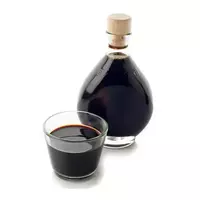Modena balsamic vinegar

Nowadays, seasoning such as balsamic vinegar is considered one of the most popular and even somewhat indispensable for the national culinary traditions of some world states. French or Mediterranean cuisine, for example, is simply unthinkable without balsamic vinegar. Historians claim that the first to make balsamic vinegar was steel in the town of Modena, which is located in Italy.
Over time, classic Modena balsamic vinegar gained popularity, which spread far beyond the historical homeland of seasoning. Professionals claim that it is Modena balsamic vinegar that has all the unique properties that help bring unforgettable taste and aroma to the finished culinary product.
It is also noteworthy that initially Modena balsamic vinegar was considered an elite product, which was available only to aristocrats, as well as royalty. In principle, the history of the spread of Modena balsamic vinegar in Europe began with a royal gift presented by the Marquis Bonifacio in 1046 to the future King Henry II.
The fact that the Marquis himself did not know became the founder of a new tradition, according to which the royals were henceforth given a keg with first-class Modena balsamic vinegar. Nowadays, Modena balsamic vinegar is not just a condiment, but a trademark that is protected from fakes by international legal acts.
There are two main types of Modena balsamic vinegar - "Aceto Balsamico Tradizionale di Modena, " as well as "Aceto Balsamico Tradizionale di Reggio Emilia. " All other variants of balsamic vinegar belong to the industrial seasoning group. This means that such a mass-produced product cannot meet the high quality standards that are imposed on traditional Modena balsamic vinegar.
According to the production technology, Modena balsamic vinegar should go through a fairly long period of aging in barrels from different types of trees. It is believed that Modena balsamic vinegar should be aged for at least 12 years. Elite and most expensive varieties of Modena balsamic vinegar are kept in wooden barrels in special conditions for at least 25 years.
The real traditional Modena balsamic vinegar has a chic and complex taste and aroma palette. The thing is that in the taste of balsamic vinegar, the distinctive properties of grapes and wooden barrels are intertwined, in which seasoning is maintained for a fairly long period of time.
In the process of preparing Modena balsamic vinegar, unlike wine vinegar, wine wort is used. Freshly squeezed juice of white grapes is boiled to a thick syrup, and then mixed with wine vinegar and maintained in wooden glasses and ash, chestnut, oak and cherry.
Modena balsamic vinegar 104 kCal
Energy value of Modena balsamic vinegar (Ratio of proteins, fats, carbohydrates - ju):
Proteins: 0.5 g (~ 2 kCal)
Fats: 0 g (~ 0 kCal)
Carbohydrates: 20.9 g (~ 84 kCal)
Energy ratio (bj | y): 2% | 0% | 80%
 Español
Español Français
Français Português
Português Русский
Русский 简体中文
简体中文 繁體中文
繁體中文 日本語
日本語 한국어
한국어 العربية
العربية Türkçe
Türkçe Қазақ
Қазақ Deutsch
Deutsch Italiano
Italiano Українська
Українська
